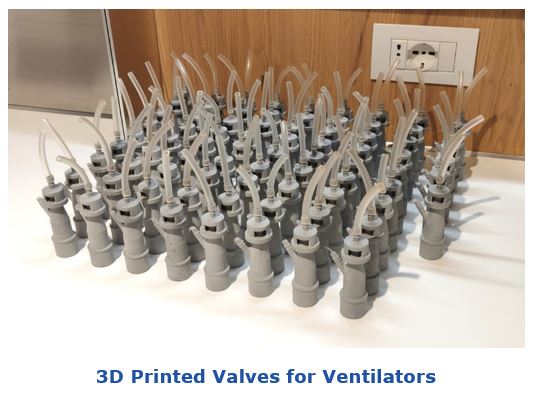

Over 700,000 people globally have been infected with the novel coronavirus. While the initial outbreak in countries like China, followed closely by Korea and Singapore has slowed, and 
Prior to the current global pandemic, additive manufacturing (AM) was penetrating many areas of manufacturing across multiple industries. The medical device area was just one of many industries that were using AM to produce innovative new parts that would have been impossible to make using conventional fabrication processes. Moreover, AM was enabling the making of replacement parts outside of the traditional manufacturing process and supply chains. Users were making replacement parts at the source for equipment in the field, from everything like military aircraft to oilfield equipment, to power generators, to critical medical equipment.
However, the coronavirus is elevating the use of AM and 3D printers, bringing the technology to the forefront of the public’s mind. The COVID-19 pandemic quickly exposed the shortages of important and life-saving healthcare equipment that were not immediately available. Critically needed parts, like valves for ventilators, can be printed on demand for hospitals and clinics where every piece of equipment was urgently needed. Much needed personal protection equipment, like protective face shields, are being 3D printed to bridge the fabrication gap for these essential items. See Open-source project spins up 3D-printed ventilator validation prototype in just one week.
One Italian company, Roboze, is exploring ways to make face masks. The company has a high-end fused deposition modeling (FDM) system that can print in PEEK, a polymer material commonly used in the medical world. They have printed molds that can be used to thermoform masks. They are also printing headbands that are combined with transparent polycarbonate sheet to make full face shields.
Components for testing kits are also being printed. One very common component is the swabs that are required—the Q-tip style specialized swabs that are required to a take a sample from the nasal cavity—and are out of stock or running out of stock very quickly across the US. Formlabs, an AM fabricator, is printing these swabs on a very large scale. On a single 3D printer, they can print almost 300 swabs at one time, and they have about 300 printers going non-stop.
Ventilators are in great demand as the number of COVID-19 cases grow, and patients require the device to literally breath and stay alive as their lungs fill with fluid and break down. While manufacturers are ramping up as quickly as possible to make new ventilators, they urgently need components, like valves, specialized fittings, splitters, filters, and pumps, to assemble and deliver the finished product. Additionally, many of the current ventilators in use often need replacement parts and additional components that will enable single ventilators to service more than one patient. AM is coming to the rescue right in the hospitals and clinics as AM companies are bringing their printers directly to the hospitals.
When a crucial component of a ventilator was not available in a hospital in Brescia, Italy, engineers from Isinnova, a local 3D printing company jumped in to help. The hospital had the ventilators and the breathing masks, but they didn’t have the connector that allowed the 
The Isinnova engineers took a sample of the valve, measured it, and re-created it in a CAD application. They then used the CAD model to 3D print a new version. Within 2 days they had produced 95 valves and quite literally saved lives. This story is one that illustrates the usefulness of AM, especially at a time when traditional manufacturing factories are struggling due to the coronavirus outbreak. During this pandemic many manufacturers don’t have the workers, because these people are quarantined at home. The supply chains are failing. While traditional manufacturing processes can produce many more parts than by 3D printing, 3D printing, conversely, can produce high quality parts in a very short time, without complex machinery, and, most importantly, without having very many people involved.

